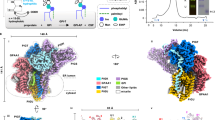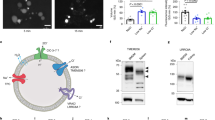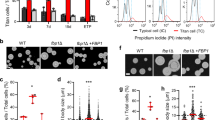Abstract
The yeast Gap1 transceptor mediates amino acid activation of the protein kinase A pathway and undergoes endocytic internalization following amino acid transport. We identified three specific γ-glutamyl dipeptides that cause persistent cyclic AMP–independent activation of protein kinase A, prevent Gap1 vacuolar sorting and cause Gap1 accumulation in endosomes. To our knowledge, these are the first examples of persistent agonists of a transceptor. In yeast mutants blocked in multivesicular body sorting, L-citrulline mimicked persistent signaling, further supporting that the internalized Gap1 transceptor keeps signaling. Unexpectedly, these dipeptides were transported by Gap1 and not by the regular dipeptide transporters. Their uptake was unusually sensitive to external pH and caused transient intracellular acidification. High external pH, NHA1 deletion or V-ATPase inhibition overcame the vacuolar sorting defect. Hence, this work has identified specific dipeptides that cause enhanced proton influx through the Gap1 symporter, resulting in its defective vacuolar sorting, and independently transform it into a persistently signaling transceptor.
This is a preview of subscription content, access via your institution
Access options
Subscribe to this journal
Receive 12 print issues and online access
$259.00 per year
only $21.58 per issue
Buy this article
- Purchase on SpringerLink
- Instant access to full article PDF
Prices may be subject to local taxes which are calculated during checkout





Similar content being viewed by others
References
Forsberg, H. & Ljungdahl, P.O. Sensors of extracellular nutrients in Saccharomyces cerevisiae. Curr. Genet. 40, 91–109 (2001).
Rubio-Texeira, M., Van Zeebroeck, G., Voordeckers, K. & Thevelein, J.M. Saccharomyces cerevisiae plasma membrane nutrient sensors and their role in PKA signaling. FEMS Yeast Res. 10, 134–149 (2010).
Holsbeeks, I., Lagatie, O., Van Nuland, A., Van de Velde, S. & Thevelein, J.M. The eukaryotic plasma membrane as a nutrient-sensing device. Trends Biochem. Sci. 29, 556–564 (2004).
Donaton, M.C. et al. The Gap1 general amino acid permease acts as an amino acid sensor for activation of protein kinase A targets in the yeast Saccharomyces cerevisiae. Mol. Microbiol. 50, 911–929 (2003).
Van Zeebroeck, G., Bonini, B.M., Versele, M. & Thevelein, J.M. Transport and signaling via the amino acid binding site of the yeast Gap1 amino acid transceptor. Nat. Chem. Biol. 5, 45–52 (2009).
Jauniaux, J.C. & Grenson, M. GAP1, the general amino acid permease gene of Saccharomyces cerevisiae. Nucleotide sequence, protein similarity with the other bakers yeast amino acid permeases, and nitrogen catabolite repression. Eur. J. Biochem. 190, 39–44 (1990).
Lauwers, E., Erpapazoglou, Z., Haguenauer-Tsapis, R. & Andre, B. The ubiquitin code of yeast permease trafficking. Trends Cell Biol. 20, 196–204 (2010).
Kriel, J., Haesendonckx, S., Rubio-Texeira, M., Van Zeebroeck, G. & Thevelein, J.M. From transporter to transceptor: signaling from transporters provokes re-evaluation of complex trafficking and regulatory controls: endocytic internalization and intracellular trafficking of nutrient transceptors may, at least in part, be governed by their signaling function. Bioessays 33, 870–879 (2011).
Thevelein, J.M. Fermentable sugars and intracellular acidification as specific activators of the RAS-adenylate cyclase signalling pathway in yeast: the relationship to nutrient-induced cell cycle control. Mol. Microbiol. 5, 1301–1307 (1991).
Hirimburegama, K. et al. Nutrient-induced activation of trehalase in nutrient-starved cells of the yeast Saccharomyces cerevisiae: cAMP is not involved as second messenger. J. Gen. Microbiol. 138, 2035–2043 (1992).
Durnez, P. et al. Activation of trehalase during growth induction by nitrogen sources in the yeast Saccharomyces cerevisiae depends on the free catalytic subunits of cAMP-dependent protein kinase, but not on functional Ras proteins. Yeast 10, 1049–1064 (1994).
Grenson, M., Hou, C. & Crabeel, M. Multiplicity of the amino acid permeases in Saccharomyces cerevisiae. IV. Evidence for a general amino acid permease. J. Bacteriol. 103, 770–777 (1970).
Hauser, M., Narita, V., Donhardt, A.M., Naider, F. & Becker, J.M. Multiplicity and regulation of genes encoding peptide transporters in Saccharomyces cerevisiae. Mol. Membr. Biol. 18, 105–112 (2001).
Hauser, M., Donhardt, A.M., Barnes, D., Naider, F. & Becker, J.M. Enkephalins are transported by a novel eukaryotic peptide uptake system. J. Biol. Chem. 275, 3037–3041 (2000).
Cai, H., Hauser, M., Naider, F. & Becker, J.M. Differential regulation and substrate preferences in two peptide transporters of Saccharomyces cerevisiae. Eukaryot. Cell 6, 1805–1813 (2007).
Didion, T., Regenberg, B., Jorgensen, M.U., Kielland-Brandt, M.C. & Andersen, H.A. The permease homologue Ssy1p controls the expression of amino acid and peptide transporter genes in Saccharomyces cerevisiae. Mol. Microbiol. 27, 643–650 (1998).
Wiles, A.M., Cai, H., Naider, F. & Becker, J.M. Nutrient regulation of oligopeptide transport in Saccharomyces cerevisiae. Microbiology 152, 3133–3145 (2006).
Vida, T.A. & Emr, S.D. A new vital stain for visualizing vacuolar membrane dynamics and endocytosis in yeast. J. Cell Biol. 128, 779–792 (1995).
Hicke, L. & Riezman, H. Ubiquitination of a yeast plasma membrane receptor signals its ligand-stimulated endocytosis. Cell 84, 277–287 (1996).
Davis, N.G., Horecka, J.L. & Sprague, G.F. Jr. Cis- and trans-acting functions required for endocytosis of the yeast pheromone receptors. J. Cell Biol. 122, 53–65 (1993).
Galan, J.M., Moreau, V., Andre, B., Volland, C. & Haguenauer-Tsapis, R. Ubiquitination mediated by the Npi1p/Rsp5p ubiquitin-protein ligase is required for endocytosis of the yeast uracil permease. J. Biol. Chem. 271, 10946–10952 (1996).
Lundh, F. et al. Molecular mechanisms controlling phosphate-induced downregulation of the yeast Pho84 phosphate transporter. Biochemistry 48, 4497–4505 (2009).
Beck, T., Schmidt, A. & Hall, M.N. Starvation induces vacuolar targeting and degradation of the tryptophan permease in yeast. J. Cell Biol. 146, 1227–1238 (1999).
Piper, R.C., Cooper, A.A., Yang, H. & Stevens, T.H. VPS27 controls vacuolar and endocytic traffic through a prevacuolar compartment in Saccharomyces cerevisiae. J. Cell Biol. 131, 603–617 (1995).
Lafourcade, C., Galan, J.M., Gloor, Y., Haguenauer-Tsapis, R. & Peter, M. The GTPase-activating enzyme Gyp1p is required for recycling of internalized membrane material by inactivation of the Rab/Ypt GTPase Ypt1p. Mol. Cell. Biol. 24, 3815–3826 (2004).
Rubio-Texeira, M. & Kaiser, C.A. Amino acids regulate retrieval of the yeast general amino acid permease from the vacuolar targeting pathway. Mol. Biol. Cell 17, 3031–3050 (2006).
Proszynski, T.J. et al. A genome-wide visual screen reveals a role for sphingolipids and ergosterol in cell surface delivery in yeast. Proc. Natl. Acad. Sci. USA 102, 17981–17986 (2005).
Markgraf, D.F. et al. The CORVET subunit Vps8 cooperates with the Rab5 homolog Vps21 to induce clustering of late endosomal compartments. Mol. Biol. Cell 20, 5276–5289 (2009).
Soetens, O., De Craene, J.O. & Andre, B. Ubiquitin is required for sorting to the vacuole of the yeast general amino acid permease, Gap1. J. Biol. Chem. 276, 43949–43957 (2001).
Dupré, S. & Haguenauer-Tsapis, R. Deubiquitination step in the endocytic pathway of yeast plasma membrane proteins: crucial role of Doa4p ubiquitin isopeptidase. Mol. Cell. Biol. 21, 4482–4494 (2001).
Kneen, M., Farinas, J., Li, Y. & Verkman, A.S. Green fluorescent protein as a noninvasive intracellular pH indicator. Biophys. J. 74, 1591–1599 (1998).
Miesenböck, G., De Angelis, D.A. & Rothman, J.E. Visualizing secretion and synaptic transmission with pH-sensitive green fluorescent proteins. Nature 394, 192–195 (1998).
Maresová, L., Hoskova, B., Urbankova, E., Chaloupka, R. & Sychrova, H. New applications of pHluorin—measuring intracellular pH of prototrophic yeasts and determining changes in the buffering capacity of strains with affected potassium homeostasis. Yeast 27, 317–325 (2010).
Trevillyan, J.M. & Pall, M.L. Control of cyclic adenosine 3′,5′-monophosphate levels by depolarizing agents in fungi. J. Bacteriol. 138, 397–403 (1979).
Thevelein, J.M. et al. Regulation of the cAMP level in the yeast Saccharomyces cerevisiae: intracellular pH and the effect of membrane depolarizing compounds. J. Gen. Microbiol. 133, 2191–2196 (1987).
Thevelein, J.M. & Beullens, M. Cyclic AMP and the stimulation of trehalase activity in the yeast Saccharomyces cerevisiae by carbon sources, nitrogen sources and inhibitors of protein synthesis. J. Gen. Microbiol. 131, 3199–3209 (1985).
Ariño, J., Ramos, J. & Sychrova, H. Alkali metal cation transport and homeostasis in yeasts. Microbiol. Mol. Biol. Rev. 74, 95–120 (2010).
Sychrová, H., Ramirez, J. & Pena, A. Involvement of Nha1 antiporter in regulation of intracellular pH in Saccharomyces cerevisiae. FEMS Microbiol. Lett. 171, 167–172 (1999).
Brett, C.L., Tukaye, D.N., Mukherjee, S. & Rao, R. The yeast endosomal Na+K+/H+ exchanger Nhx1 regulates cellular pH to control vesicle trafficking. Mol. Biol. Cell 16, 1396–1405 (2005).
Nikko, E., Marini, A.M. & Andre, B. Permease recycling and ubiquitination status reveal a particular role for Bro1 in the multivesicular body pathway. J. Biol. Chem. 278, 50732–50743 (2003).
Helliwell, S.B., Losko, S. & Kaiser, C.A. Components of a ubiquitin ligase complex specify polyubiquitination and intracellular trafficking of the general amino acid permease. J. Cell Biol. 153, 649–662 (2001).
Hopkins, P., Shaw, R., Acik, L., Oliver, S. & Eddy, A.A. Fluorocytosine causes uncoupled dissipation of the proton gradient and behaves as an imperfect substrate of the yeast cytosine permease. Yeast 8, 1053–1064 (1992).
Rajagopalan, S. Endosomal signaling and a novel pathway defined by the natural killer receptor KIR2DL4 (CD158d). Traffic 11, 1381–1390 (2010).
Roberg, K.J., Rowley, N. & Kaiser, C.A. Physiological regulation of membrane protein sorting late in the secretory pathway of Saccharomyces cerevisiae. J. Cell Biol. 137, 1469–1482 (1997).
Chen, E.J. & Kaiser, C.A. Amino acids regulate the intracellular trafficking of the general amino acid permease of Saccharomyces cerevisiae. Proc. Natl. Acad. Sci. USA 99, 14837–14842 (2002).
Colombo, S. et al. Involvement of distinct G-proteins, Gpa2 and Ras, in glucose- and intracellular acidification-induced cAMP signalling in the yeast Saccharomyces cerevisiae. EMBO J. 17, 3326–3341 (1998).
Acknowledgements
We would specially like to thank H. Sychrova and members of her laboratory, L. Maresova and O. Kinclova-Zimmermanova for their help and guidance in the intracellular pH measurements. We thank W. Verheyden and R. Wicik for technical help with the experiments, N. Vangoethem for help with preparation of the figures and V. Diaz for helping us with organochemistry calculations and concepts. We would also like to thank all researchers that have kindly provided us with strains, plasmids and antibodies from their laboratories (mentioned in Supplementary Tables 1 and 2). This work was supported by an European Commission–Marie Curie fellowship to M.R.-T., by Fonds Wetenschappelijk Onderzoek visiting and postdoctoral fellowships to M.R.-T. and G.V.Z. and by grants from the Fund for Scientific Research–Flanders, Interuniversity Attraction Poles Network P6/14, the Research Fund of the KU Leuven (Concerted Research Actions) and the Hercules Foundation (Flanders).
Author information
Authors and Affiliations
Contributions
G.V.Z. and M.R.-T. performed the experimental work and contributed with J.M.T. to the design and discussion of the experimental work and the writing of the paper.
Corresponding author
Ethics declarations
Competing interests
The authors declare no competing financial interests.
Supplementary information
Supplementary Text and Figures
Supplementary Methods and Supplementary Results (PDF 17351 kb)
Rights and permissions
About this article
Cite this article
Rubio-Texeira, M., Van Zeebroeck, G. & Thevelein, J. Peptides induce persistent signaling from endosomes by a nutrient transceptor. Nat Chem Biol 8, 400–408 (2012). https://doi.org/10.1038/nchembio.910
Received:
Accepted:
Published:
Issue date:
DOI: https://doi.org/10.1038/nchembio.910
This article is cited by
-
Yeast nutrient transceptors provide novel insight in the functionality of membrane transporters
Current Genetics (2013)



